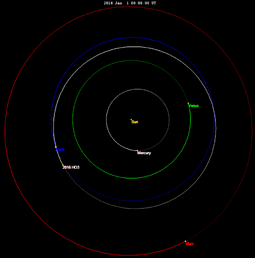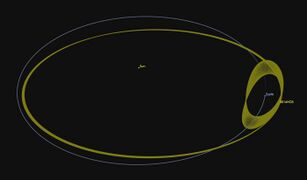Astronomy:(469219) 2016 HO3
 Orbit of 2016 HO3 in the inner Solar System | |
| Discovery [1][2] | |
|---|---|
| Discovered by | Pan-STARRS |
| Discovery site | Haleakala Obs. |
| Discovery date | 27 April 2016 |
| Designations | |
| (469219) 2016 HO3 | |
| 2016 HO3 | |
| Minor planet category | NEO · Apollo [1][2] Earth quasi-satellite [3][4] |
| Orbital characteristics [1] | |
| Epoch 4 September 2017 (JD 2458000.5) | |
| Uncertainty parameter 0 | |
| Observation arc | 13.20 yr (4,820 days) |
| |{{{apsis}}}|helion}} | 1.1055 AU |
| |{{{apsis}}}|helion}} | 0.8973 AU |
| 1.0014 AU | |
| Eccentricity | 0.1040 (~530 wrt Earth)[lower-alpha 1] |
| Orbital period | 1.00 yr (366 days) |
| Mean anomaly | 331.49° |
| Mean motion | 0° 59m 0.96s / day |
| Inclination | 7.7741° |
| Longitude of ascending node | 66.407° |
| 306.93° | |
| Earth MOID | 0.0348 AU · 13.6 LD |
| Physical characteristics | |
| Dimensions | 0.041 km (calculated)[5] 0.04–0.10 km[4] |
| Rotation period | 0.467±0.008 h[lower-alpha 2] |
| Geometric albedo | 0.20 (assumed)[5] |
| S (assumed)[5] | |
| Absolute magnitude (H) | 24.2[1] · 24.3[5] |
(469219) 2016 HO3 is a micro-asteroid, fast rotator and near-Earth object of the Apollo group, approximately 41 meters in diameter. It is currently the smallest, closest, and most stable (known) quasi-satellite of Earth. The asteroid was discovered by Pan-STARRS at Haleakala Observatory on 27 April 2016.[2]
Orbit and classification
2016 HO3 orbits the Sun at a distance of 0.9–1.1 AU once every 366 days. Its orbit has an eccentricity of 0.10 and an inclination of 8° with respect to the ecliptic.[1] It has an Earth minimum orbital intersection distance of 0.0348 astronomical unit|AU (5,210,000 km) which translates into 13.6 lunar distances.[1]
Quasi-satellite of Earth
As it orbits the Sun, 2016 HO3 appears to circle around Earth as well. The object is beyond the Hill sphere of Earth and the Sun exerts a much stronger pull on it than Earth does. Although it is too distant to be considered a true natural satellite of Earth, it is the best and most stable example to date of a near-Earth companion, or quasi-satellite.[3]
"Since 2016 HO3 loops around our planet, but never ventures very far away as we both go around the Sun, we refer to it as a quasi-satellite of Earth", said Paul Chodas, manager of NASA's Center for Near-Earth Object (NEO) Studies at the Jet Propulsion Laboratory in Pasadena, California.[4]
"One other asteroid – 2003 YN107 – followed a similar orbital pattern for a while over 10 years ago, but it has since departed our vicinity. This new asteroid is much more locked onto us. Our calculations indicate 2016 HO3 has been a stable quasi-satellite of Earth for almost a century, and it will continue to follow this pattern as Earth's companion for centuries to come." — [4]
In its yearly trek around the Sun, asteroid 2016 HO3 spends about half of the time closer to the Sun than Earth is (that is, the asteroid is inside the Earth's orbit) and passes ahead of our planet, and about half of the time farther away (crosses outside Earth's orbit), causing it to fall behind. Its orbit is also tilted a little, causing it to bob up and then down once each year through Earth's orbital plane. In effect, this small asteroid is caught in a game of leap frog with Earth that will last for hundreds of years.[4]
The asteroid's orbit also undergoes a slow, back-and-forth twist over multiple decades. "The asteroid's loops around Earth drift a little ahead or behind from year to year, but when they drift too far forward or backward, Earth's gravity is just strong enough to reverse the drift and hold onto the asteroid so that it never wanders farther away than about 100 times the distance of the moon", said Chodas. "The same effect also prevents the asteroid from approaching much closer than about 38 times the distance of the moon. In effect, this small asteroid is caught in a little dance with Earth."[4]As of now, it has by far the most stable quasi-satellite of Earth discovered, in terms of orbit.
Physical characteristics
The size of 2016 HO3 has not yet been firmly established, but it is likely about 40–100 m (130–330 ft).[4] Based on an assumed standard albedo for stony S-type asteroids of 0.20 and an absolute magnitude of 24.3, it measures 41 meters (135 ft) in diameter.[5]
Photometric observations in April 2017 revealed that 2016 HO3 is a fast rotator. Lightcurve analysis gave a rotation period of 0.467 ± 0.008 hours (28.02 ± 0.48 minutes) and a brightness variation of 0.80±0.05 magnitude ({{{1}}}).[5][lower-alpha 2]
Discovery and naming
Asteroid 2016 HO3 was first spotted on 27 April 2016, by the Pan-STARRS 1 asteroid survey telescope on Haleakalā, Hawaii, operated by the University of Hawaii's Institute for Astronomy and funded by NASA's Planetary Defense Coordination Office.[4] As of 2018, the object has not been named.[2]
Gallery
Asteroid 2016 HO3 orbiting the Sun and Earth (animation; file).
See also
- Arjuna asteroid
- Natural satellite
- Quasi-satellite
- 3753 Cruithne
- 6Q0B44E
- 2001 GO2
- 2002 AA29
- 2003 YN107
- 2006 JY26
- 2006 RH120
- 2012 FC71
- 2013 BS45
- (419624) 2010 SO16
- (436724) 2011 UW158
Notes
- ↑ Computed with JPL Horizons using a geocentric solution. Ephemeris Type: Orbital Elements / Center: 500 / Time Span: 2017-Sep-04 (to match infobox epoch)
- ↑ 2.0 2.1 Exceptional rotation period of 0.467 ± 0.008 hours (28.02 ± 0.48 minutes) with a brightness amplitude of 0.80±0.05 mag, quality code = 2, (Reddy 2018).[5] Not yet listed on ADS (Nov 2017). Summary figures at the LCDB.[5]
References
![]() This article incorporates public domain material from websites or documents of the National Aeronautics and Space Administration.
This article incorporates public domain material from websites or documents of the National Aeronautics and Space Administration.
- ↑ 1.0 1.1 1.2 1.3 1.4 1.5 "JPL Small-Body Database Browser: 469219 (2016 HO3)". Jet Propulsion Laboratory. http://ssd.jpl.nasa.gov/sbdb.cgi?sstr=2469219. Retrieved 19 November 2017.
- ↑ 2.0 2.1 2.2 2.3 "(469219) = 2016 HO3". IAU. http://www.minorplanetcenter.net/db_search/show_object?object_id=469219. Retrieved 19 November 2017.
- ↑ 3.0 3.1 de la Fuente Marcos, C.; de la Fuente Marcos, R. (November 2016). "Asteroid (469219) 2016 HO3, the smallest and closest Earth quasi-satellite". Monthly Notices of the Royal Astronomical Society 462 (4): 3441–3456. doi:10.1093/mnras/stw1972. Bibcode: 2016MNRAS.462.3441D. https://arxiv.org/pdf/1608.01518.pdf. Retrieved 19 November 2017.
- ↑ 4.0 4.1 4.2 4.3 4.4 4.5 4.6 4.7 Agle, DC; Brown, Dwayne; Cantillo, Laurie (15 June 2016). "Small Asteroid Is Earth's Constant Companion". Jet Propulsion Laboratory. https://www.jpl.nasa.gov/news/news.php?feature=6537. Retrieved 19 November 2017.
- ↑ 5.0 5.1 5.2 5.3 5.4 5.5 5.6 5.7 "LCDB Data for (469219)". Asteroid Lightcurve Database (LCDB). http://www.minorplanet.info/PHP/GenerateALCDEFPage_Local.php?AstInfo=469219%7C. Retrieved 19 November 2017.
External links
- 2016 HO3 at NeoDyS-2
- Asteroid 2016 HO3 - Earth's Constant Companion NASA Jet Propulsion Laboratory, Jun 23, 2016
- Asteroid Lightcurve Database (LCDB), query form (info)
- Discovery Circumstances: Numbered Minor Planets (465001)-(470000) – Minor Planet Center
- (469219) 2016 HO3 at the JPL Small-Body Database





